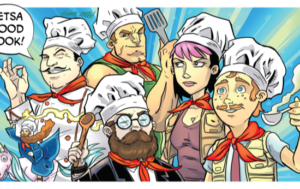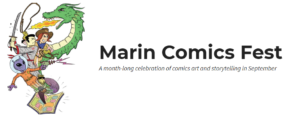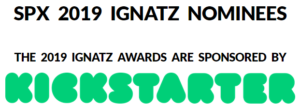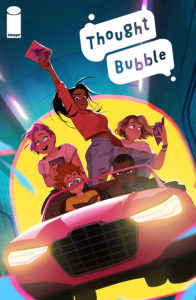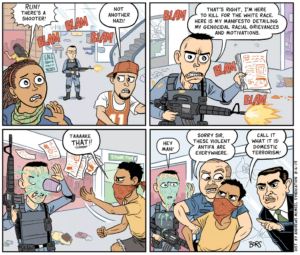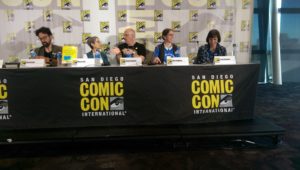I had a picture of the panel, but it was one of the ones that got eaten by my phone, dammit.
[Editor’s note: This will be the last of our SDCC 2019 panel recaps. Exact quotes, italics, etc, you know the drill, but since there were so many go back-and-forth elements to the answers, I’m going to do my best to identify who made each of the paraphrased points.]
I went to the panel on how magic and technology can coexist in fiction on a whim, and I’m glad I did. Moderator Lilah Sturges did the best panel-wrangling job I saw in San Diego, tossing questions, prompting useful digressions, keeping things moving, and avoiding the dreaded Now each of you answer the same question in depth, one after another at all costs. A’course, when the panel includes Ursula Vernon, Bree Paulsen, Gene Ha¹, Carey Pietsch, Maya Kern, and Katie O’Neill on the panel, there were plenty of opinions to go around.
The only Okay, everybody answer this question was the first which was Is Star Wars sci-fi? Clarke talked about sufficiently advanced technology being indistinguishable from magic, and if it is, what’s the difference? Nerd senses tingling, hands involuntarily clenching, takes heating to the searing point, the panel was on notice that they’d have to bring their A-game, and the audience was primed to be invested in the answers. While the panel pretty much all dodged the first part of the question, they dug into the second with their own thoughts on the differences.
Kern: We can at least pretend to understand technology.
O’Neill: Technology is created for a purpose and direction, magic isn’t.
Paulsen: It depends on how characters interact with it.
Vernon: Technology is replicable, magic is just Yer a wziard, Harry. Sometimes it’s democratic, sometimes it’s Luke, you’re a Jedi but nobody else is or can be.
Paulsen: It’s the difference between created (technology) and channeled (magic).
Pietsch: Are you reading Witch Hat Atelier? Spoiler warning: people in the story believe that magic is inherent to witches and nobody else can use it, but it turns out that it’s a skill set. I really enjoy stories that tread that line.
Paulsen: I like stories where technology is used to direct or harness magic.
Vernon: Spontaneity is key — magic can just exist out in the woods on its own, but an iPad doesn’t just happen.
Ha: Mary Shelley is regarded as the first science fiction writer, but you could say that she wrote a story of a wizard who engaged in forbidden rituals. Frankenstein is a fantasy story but it’s told in terms of technology, these new discoveries. She invented the mad scientist.
Kern: Bottom line: technology needs people to make it/use it, but magic can just exist on its own.
Notice that back and forth? It worked great. Sturges’s later questions didn’t request that everybody answer, they were just lobbed out there and people had a conversation until they’d all made the points they wanted to. Panels that turn into an open discussion by smart, engaged people rock, and I wish every session at SDCC ran like this one did. The next question asked the panel how they use technology and magic for different kinds of stories.
Paulsen: Okay, we all know vampire lore, you can’t take their picture, but I’ve decided that was because film cameras have a bunch of mirrors in them, and your phone doesn’t, so you can get a selfie with a vampire if you wanted to. I like to find workarounds to folklore.
O’Neill: I love the intersection of magic and domesticity, or magic tied to a skill like weaving or blacksmithing.
Pietsch: I like using magic as a craft but also as a way to put characters into situations we don’t have a framework for.
Vernon: I have a story set in the Old West where the trains became sentient, then became gods, so they obviously needed priests. It’s tech becoming suddenly huge and disruptive, it must have looked like magic to the people seeing it for the first time …
Sturges: I want to do any exorcism with a train priest.
Ha: I HAVE DISCOVERED MUZAK’S TRUE NAME, NOW I HAVE POWER OVER IT.
O’Neill: One thing I like to do is think of limitations on magic, like you’d get with technology. [Editor’s note: somebody please write a story where magic is limited by the equivalent of battery life, or no signal.]
Ha: Samuel Johnson, in the 18th century, said the job of Art is to make the everyday magic, and make the magic everyday. When creating these systems, like the train priests, those engineers were folk heroes, so your metaphor about life back then …
Vernon: Who among us has not seen Elon Musk treated as a prophet?²
Pietsch: The edge cases are the most interesting to me. Maybe you could never achieve this [gestures to indicate modern life] with magic, now how do you get round that?
The panel firing on all cylinders (technology reference!), Sturges lobbed the big one at them: What is the difference between fantasy and science fiction?
Pietsch: Gatekeeping? [applause break]
Sturges: Okay, next question! [laughter break]
Paulsen: I think science fiction is where people are starting to understand something and ask But what if it went this far? It can be anything, and the line gets blurry.
Vernon: I’d say sci fi has a could happen vibe, and fantasy more this could never happen.
Paulsen: But the line is still blurry, especially as we learn about space. Black holes, cool! That’s magic!
Ha: In an earlier panel, a woman said the difference is gendered. In Star Wars, Luke is a princess, Ben is a fairy godmother, Vader is the evil step-parent …
Vernon: And he has a Death Star instead of a dragon!
Sturges: So science fiction concentrates more on how, and fantasy more on why?
Vernon: Yeah, but you can think about a million counterexamples. Lots of sci fi doesn’t care about how; How does acid blood work? I dunno, but it looks cool.
Pietsch: I feel like it’s a matter of framework, not definition. What was the author interested in?
Vernon: The stories that Trek wanted to tell were Why were humans like this? Why were aliens like this? That one Next Generation with the ugly bags of mostly water? That was hard-SF. The rest, not so much.
With that settled, it was time for the key question: Can technology and magic coexist in the same story?
Paulsen: I want a story where a witch can send a message around the world for you, but a text arrives first.
Vernon: Modern technology mixed with magic stories rely on hidden worlds a lot. I think they can coexist, but adult muggles have to be really dense for those stories to work at all.
Ha: Almost every good story is a mystery story. Magic is all about mystery. We can look up the answers to anything, so a lot of the storytelling depends on trying to figure out new kinds of questions.
Kern: You could say that augmented reality could be a form of magic.
Pietsch: If you could get persistent, self-sustaining augmented reality, that would be magic.
Sturges threw open the session to audience questions, and made an observation that should be made at every panel: Questions end in a question mark, and should fit in a tweet. It worked, too! No grandstanding, no manifestos, no explanations to the panel about how they’re wrong and bad and wrong some more. Bliss!
Question: What are some examples of blended magic and tech in your own work?
Sturges: I have witches researching spell components, inspired by bioresearchers that use supercomputers and simulations to explore new drugs via algorithm.
Vernon: Train priests³.
Paulsen: Vampires and cameras.
Ha: Mae is portal fiction, with mad science, pre-human technology, and magic plus technology mixing.
Pietsch: I have elevators in a medieval fantasy setting. I like to draw technology and have the characters just run with it
Kern: Snapchat filters are magic in real life.
O’Neill: My Tea Dragons grow tea, but it’s about how technology can be quick, efficient, accessible, but also you end up overlooking the older (and still valuable) methods.
Question: In stories, the role of magic is often to empower, but technology serves to isolate and polarize. Can we get magic to solve these troubles for us?
Vernon: I suspect that if magic existed the same things would happen, but that doesn’t make good books.
Kern: Allow me to introduce you to every old, weird magic hermit in fiction.
Ha: In art history, there’s always the images of saints tormented by demons, which makes me think that Hieronymus Bosch4 was just foreseeing the internet.
Vernon: [with gravity] We are all Saint Anthony.
Question: How do you address the complexity in the systems of modernity, the Industrial Revolution, and such? Do we need a story that can serve as a cautionary about climate change?
Vernon: One point I wanted to make about the train priests was the trains were no longer under the control of the financiers and rail barons that paid to build the rails. When the decided on priests, they looked to the people they’d seen work and die to build, so 2/3 of the train priests are Chinese, black, Irish, a few Cornish. Troops got sent and the trains ate them.
Paulsen: Thomas, no! I remember a Discworld book that talked about the pollution of a river; magic mining was going on but the side effects were still there.
Pietsch: Was that Thud!?
Vernon: Could be The Fifth Elephant.
Paulsen: A real world example: companies are harvesting white sage unsustainably, which is needed for ecological balance, but we’re all witches now.
Sturges: Also there are eye of newt shortages, newts just bumping into each other.
Question: There are two discourses here; what about the stories we’re telling ourselves in a post-truth world. I don’t know if you saw the anti-vaxxers parading around, there’s magical thinking …
Pietsch: Oh, you mean lies. [applause break]
Vernon: I think we could use some hopeful stories about, say, climate change. Grief is paralyzing, and it’s hard. I’ve tried to write about dealing with this new world, how do we deal with it and what do we influence? If there were easy answers, we’d be doing it.
Paulsen: Tommorowland tried to address this, but it didn’t quite land.
Vernon: How we can write stories to make people not listen to Fox News? I got nuthin’.
Paulsen: I recommend NK Jemisen’s The Broken Earth books. They’re about facing a global catastrophe, but hopeful.
Question: Okay, so muggles are dumb. How do we write stories with non-dumb magical systems included?
Vernon: I just make all the shamans homeless, and everybody ignores them.
Ha: I’ve worked a lot with Alan Moore, and in his system, magic is language.
Whew! That’s a lot of transcribing, but it was worth it. Follow all of the folks that took part, and thanks again to Lilah Sturges for a magnificent job of keeping things rolling.
Spam of the day:
Is international dating more trouble than it on most DAYS during his commute from Green Lake to his Georgetown office, Alejandro Pea is observing his phone.
I can’t tell if international dating is meant to refer to dating across national borders, or just the run-of-the-mill mail-order bride deal. Clarity, please!
_______________
¹ Who spent time thinking about answers by sketching folks in the front row or so of the audience, then presenting them with the portraits.
² Me and Vernon’s husband Kevin who I was sitting next to: [stiffen and subvocalize growls, as if to express the thought Fuck that guy.]
³ Because the question came up, you can find the train priests in the novelette The Tomato Thief, which won a Hugo. The story features Grandma Harken, who also featured in the Nebula-winning short story Jackalope Wives. I love Vernon’s cantankerous, wise old women that smart folks know not to cross.
4 Weirdly, this was the second time Bosch came up at SDCC for me, and Carey Pietsch was present for both of them.
